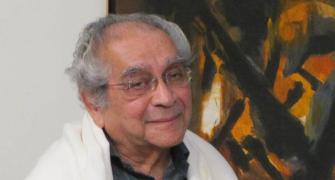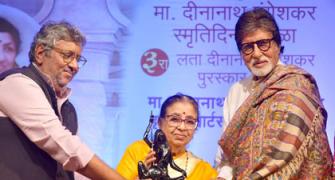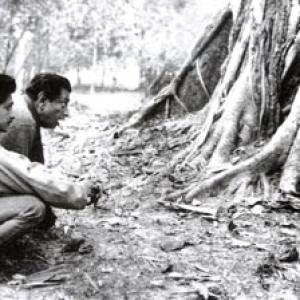Nemaida's misfortune in life was to be known as Satyajit Ray's 'Boswell'; History will remember Satish Gujral as a renaissance man whose imprint over New Delhi is huge.
Kishore Singh salutes two artistes who passed into the ages last week.
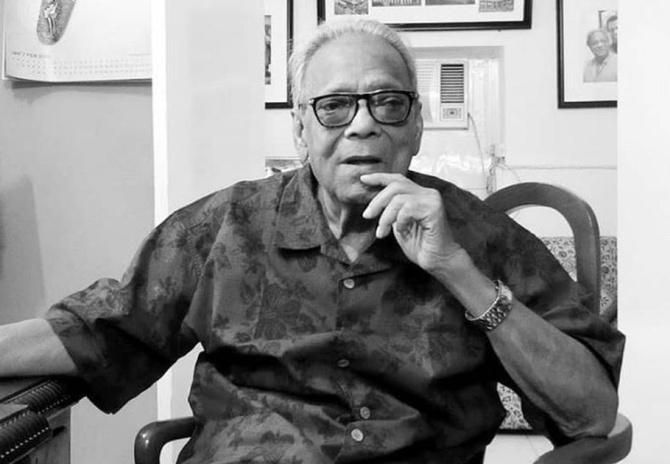
Nemai Ghosh (1934-2020)
In July 2018, Nemai Ghosh wrote me an e-mail announcing the news of his death.
We had been working on a project with erratic, flexible deadlines, and he was frustrated about its lack of progress.
Leading news channels, he wrote, had "struck gold with this news" but "to their disappointment, they found me working at my desk".
Nemaida often employed both humour and sarcasm, and I was unsure whether he had made up the "news" to get me to rally faster.
Nemaida's misfortune in life was to be known as Satyajit Ray's 'Boswell'; a theatre artiste-turned amateur photographer who honed his skills for 25 years on Manikda's sets, shadowing him through his library, capturing tender moments of the auteur with his wife, for it will be as Ray's photographer that history will acknowledge him.
And rare honour though that was, Nemaida was much more than Ray's chronicler -- his work on theatre in Kolkata is of thespian quality, his photographs on tribals have rarely been seen, he photographed the city of his birth, and, now, death, ceaselessly, and he has documented the lives of innumerable artists, all of which will live on beyond him.
What everyone acknowledged was his passion for his work and his dedication to his craft.
He refused to work in the digital format, choosing to shoot only with film rolls.
He abjured the use of flash, preferring depth over notional clarity or glamour.
A large, handsome man, he was erudite, his letters and emails always properly correct, as bhadralok as the man he admired -- Ray -- and, like him, conscientious to a fault.
I first met him for a story for Business Standard, and happenstance brought us closer when we worked together on a defining project of Ray photographs (Satyajit Ray and Beyond, DAG: 2013).
Our next project took longer than we had anticipated during the course of which Nemaida's wife took ill, and he himself became bedridden after a fall from his bed. "I swim every day and maintain a proper diet to stay fit," he wrote to me.
"I must stay healthy to complete all my pending work." That included Faces and Facets: Satyajit Ray in Colour, an exhibition that opened in Kolkata's Old Currency Building in January this year.
Nemaida, though, could not attend it in his bedridden state, nor was he able to visit it thereafter, though the book brought him solace.
"So many calls came," he wrote to me of his fake death, "I was relieved to know that so many people still remember me, love my work and are my well-wishers."
He would be gladdened to know that his passing has saddened thousands whose tributes, alas, have had to be restricted to social posts.
***
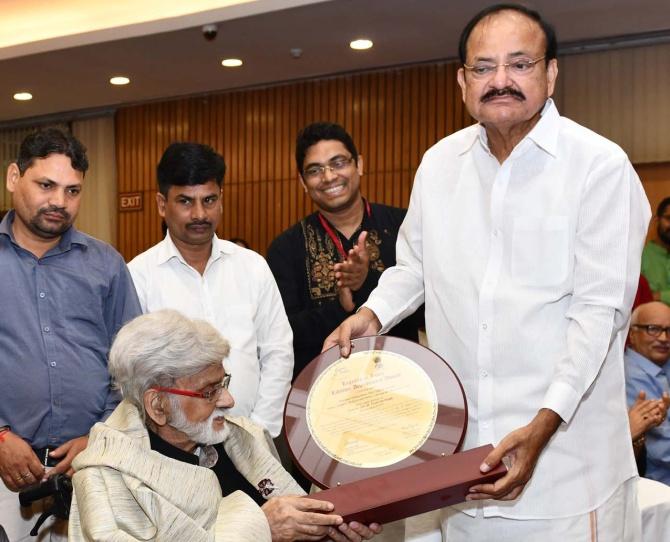
Satish Gujral (1925-2020)
Barely had one got over Nemaida's passing when news came of the death of Satish Gujral.
Ninety four years old, Gujral was the epitome of a gentleman artist -- elegant, eloquent, passionate and loyal to a fault.
Hearing impaired, a Partition survivor, he was -- despite his disability -- a raconteur who one turned to frequently for narratives and anecdotes.
Till recent years when he and his wife, Kiran, found themselves increasingly homebound from ill-health, you could hardly live in the city without crossing paths with them.
Gujral made it a point to attend most art events and offer encouragement. He always greeted acquaintances with a warm embrace and carefully chosen words.
History will remember Gujral as a renaissance man whose imprint over New Delhi is huge. Several public buildings are fronted by his murals created mostly in the sixties.
Ironically, my first meeting with him was not as an artist, but as an architect.
He had designed the Belgian embassy in the capital to great acclaim, and had turned his attention next to a group of farmhouses where we met.
He walked me around with much aplomb, enjoying the theatre, the narrow corridors opening into grand entertainment spaces.
We made it a point to meet frequently thereafter, a period in which I became increasingly familiar with his immense body of work that included ceramics, burnt wood sculptures, and, of course, his paintings.
Gujral's signature, by then, epitomised glamour, and his work increasingly began to cater to this segment of society.
But it is his work on Partition -- the reason he was chosen to go to Mexico on a scholarship -- that will be forever associated with him.
These poignant paintings are markers of immeasurable human sorrow and pain and a reminder that Gujral himself never overcame the tragedy of the sundering of the subcontinent.
Any conversation on the subject would cause his voice to quiver with anger, his eyes to well up.
The last time these reminisces caused him such consternation, Kiranji gestured for me to leave. It was the last time we met.




